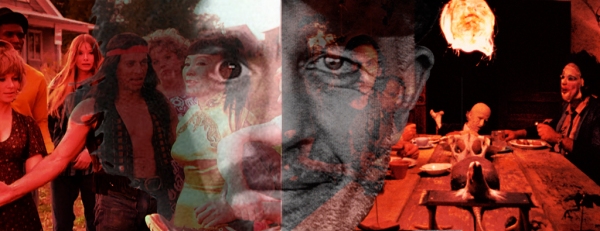By Ethan Tarantella For a film as schlocky and tasteless as Herschell Gordon Lewis’s Two Thousand Maniacs!, there are some interesting themes going on throughout it. Beyond the violence, the low-budget special effects, and the dark sense of humor, it is interesting how it takes place in a Confederate town ironically named Pleasant Valley that’s... Continue Reading →
Wes Craven and the Metanarrative Slasher Film
Wes Craven’s films often pay homage to horror. The conventions and themes utilized in a Craven film are playfully aware of the confines of both their genre and the medium of film at large. Looking at three of his most reflective films, this metanarrative commentary can be broken down and understood as both horrifying and creatively boundary breaking. I will examine, in order of release, Wes Craven’s New Nightmare (1994), Scream (1996), and Scream 3 (2000), looking at both the evolution of Craven’s metanarrative commentary and the function it serves in adding to the fright in each film, and how this narrative reflection has affected horror as a whole.
Big Impacts, Small Footprints.
THE HUMAN SUBPLOT IS THE PLOT “Monsters are tragic beings,” Godzilla co-creator Ishiro Honda was onto something when he observed, “They are born too tall, too strong, too heavy. They are not evil by choice. That is their tragedy.” Humanity is at the heart of the best monster stories. It’s not by accident that... Continue Reading →
The Postmodernism of Wes Craven’s Scream
By Kole Phelps “What’s your favorite scary movie?” is a question that can mean two things to a horror fan. For some, it’s just a straightforward question, but for others, it brings to mind the image of Drew Barrymore dissolving into terror as a masked killer on the phone asks her the same question. Scream... Continue Reading →
The Top 10 New (To Me) Horror, Cult, and Exploitation Films of 2020
These are films that I saw for the first time in 2020, not necessarily new films.
Visceral and Existential Horrors: The Root of Terror in John Carpenter’s The Thing and David Cronenberg’s Videodrome
Both John Carpenter’s The Thing and David Cronenberg’s Videodrome grapple with the idea of human evolution and our place in the world around us. While both films use quite different methods to communicate their fears, the focus of the horror elements center on the shifting state of nature.
Scenes and Scenery: Versions of The Masque of the Red Death
By Sarah Winkler The process of translating works to different mediums calls for a subjective ‘originality,’ in that elements in a given adaptation are often something reworked, if not added or subtracted when moved from one format to another. In the case of transmuting classic literature to classic film, there is a similar need for... Continue Reading →
‘Shin Godzilla’ Stomps Closer to Home After Covid-19
It isn’t that I believe Toho and co. were making a Godzilla film about the coronavirus in 2016, that would require a tin-foil hat and perhaps an antipsychotic prescription.
Hippies in Hell in the Heartland: How I Drink Your Blood and The Texas Chain Saw Massacre Mirror the Culture Wars in America
...in the early to mid 1970’s two films would emerge that would use this theme to explore the two very different sides of the conversation, creating metaphors for what happens when city progressives are confronted with rural traditionalists in their own environment. I Drink Your Blood (1971) and The Texas Chain Saw Massacre (1974) would each create an aggressively oversimplified and terrifyingly singular antagonistic “family” which not only held up a mirror to the times in which the films were created, they held up and almost perfectly reflected each other.
Alone in the Dark: A Manifesto on the Power of Watching Films at Home
By Aaron AuBuchon There’s a truism amongst cinephiles that runs so strong and so deep that to suggest otherwise is to risk ridicule, banishment, ritual torture and summary execution. And that is that it is best to watch a film in a theater with a large audience. This is always presented as an a priori... Continue Reading →








